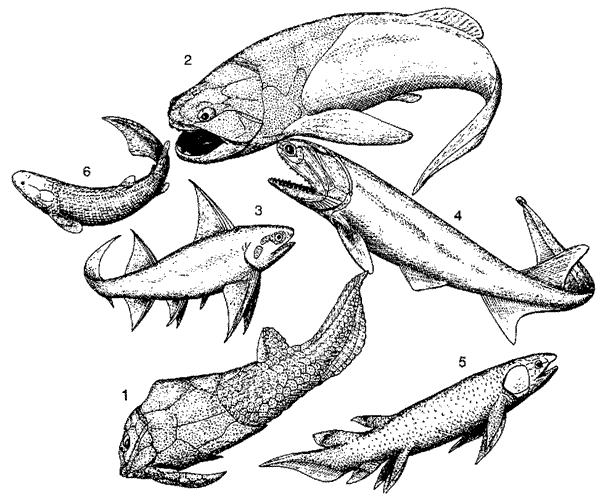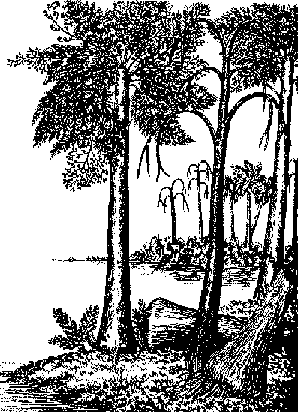Dechenella macrocephalus
Hamilton Group, New York. Dorsal view
(Kevin's Trilobite Homepage)
| Middle Devonian Epoch | ||
| Paleozoic: Devonian Period |
The Givetian Age |
| Eifellian | Early Devonian | Middle Devonian | ||
| Frasnian | Late Devonian | Timescale |
Stratigraphic distribution patterns for Givetian and Frasnian gastropods of the Polish segment of southern shelf of Euramerica (Holy Cross Mountains and Krakow areas) indicates that the late Givetian was marked by radical impoverishment in gastropods, connected with Taghanic and Manticoceras events. [ref Gastropods from Givetian and Frasnian of southern Poland and the global biotic crises - Number 04 (April) 1999, Volume 47 of Przegl?d Geologiczny (Geological Review, Polish Geological Institute)
![]()
Dechenella macrocephalus
Hamilton Group, New York. Dorsal view
(Kevin's Trilobite Homepage)

Greenops boothi
Widder Shale, Hamilton Group,
Arkona, Ontario, Canada
(Kevin's Trilobite Homepage)

Fishes of the Middle Devonian locality of Lethen Bar, in Scotland Givetian, about 377 Ma). They include antiarchs 1 Pterichthyodes); and arthrodire 2. Coccosteus) placoderms, acanthodians 3. Diplacanthus), ray-finned fish (4, Cheirolepis), lungfish 5, Dipterus), and osteolepiform lobe-finned fish (6. Osteolepis), representing the lineage that gave rise to land animals.
Reconstruction from Philippe Janvier's book Early Vertebrates, (Clarendon Press, Oxford) p, 9
 the lycopsid Archaeosigillaria (center) together with the progymnosperm Aneurophton (left, the fern-tree like plant), representatives of the flora from the Gilboa Forest (Catskill Mountains, New York). None of these plants grew very tall. Note the mushroom-like bases (absence of true root system) the lycopsid Archaeosigillaria (center) together with the progymnosperm Aneurophton (left, the fern-tree like plant), representatives of the flora from the Gilboa Forest (Catskill Mountains, New York). None of these plants grew very tall. Note the mushroom-like bases (absence of true root system) from The Fossil Book - Fenton & Fenton, 1958, Doubleday & Co., p.284 see also The First Forests |
By the Givetian epoch trees had grown large enough to form forests. These trees belonged to ancient groups of plants like progymnosperms and lycopsids, and reproduced by spores, as ferns still do today. These trees still lacked proper roots, and the base of the trunk swelled out like the bottom of a mushroom, another primitive land dweller. These trees also provided very little shade or shelter, having a crown of open branches or large fronds instead of proper leaves.
Differences in composition of two assemblages from the Middle Devonian of New York State, USA, one dominated by progymnosperms and ferns, the other by sphenopsids and lycopsids, have tentatively been related to differences in habitats, with the second of these assemblages perhaps occupying a similar niche to the late Carboniferous swamp floras. It is possible, however, to generalize a little on the structure of communities. The acquisition of a lateral meristem, for ex- ample, allowed an increase in girth and hence greater height. This would have led to the development of a forest with many different layers of foliage and an increase in the types of habitat available for colonization by animals. Some of these habitats would have been deeply shaded, and here the heterosporous condition and possession of seeds would have been advantageous, as the food reserves of the female gametophyte tissues in the seed would have allowed the young sporophyte to develop without the need for immediate photosynthesis. The seed habitat would also have allowed the colonization of much drier environments
The recently discovered Middle Devonian Gilboa fauna contains flattened fragments of trigonotarbids, centipede fangs, a spider, a mite and a bristletail, another wingless insect.
Evolutionary Ecology and Coordinated Stasis of Devonian Benthic Faunas in the Appalachian Basin (link http://ucaswww.mcm.uc.edu/geology/brett/deptwebpage/coordin.htm no longer valid)